Over the last couple of months I have been steering the design of the Ancient Lands away from true sandbox environments towards something more of an expedition focused nature. Adventures more in the style of David Cook’s The Isle of Dread and Dwellers of the Forbidden City. Civilization and culture is increasingly moving into the background in favor of greater attention to environments in which actual adventures are playing out. But the setting is not just aimed at being a stage for dungeon crawls, but for entire expeditions from the planning to the eventual triumphant return laden with gold. This makes the settlements through which the party passes along the way an important and integral element of both the adventures and the setting.
During a discussion about the development of the setting I mentioned that all proper civilization is located along the rivers and coast, which led to the natural question what the deal is with all the communities not located directly on this primary trade network of waterways. While trying to express how I was imagining minor settlements, this idea of Three Degrees of Civilization evolved naturally while I was typing a response. (Which is why I always love writing about my design process. A lot of great ideas arise from that.) It all goes back to the Hill Cantons idea of Corelands, Borderlands, and the Weird, with which it overlaps, but is not identical. In the Ancient Lands, the starting towns would be corelands where everything is ordinary; the wilderness is the borderlands, where things are getting strange and threatening; and the ruins and caves of the main adventure sites would be the weird, where the Mythic Underworld is fully realized. In a slight twist, cities are not part of the corelands but of the borderlands. So many people living together in a massive construction of stone is just not natural and alien to the ordinary clanspeople from which PCs come.
But not all villages are equal. While the towns from which expeditions start are clearly part of the corelands and some of the early settlements are welcome islands of safety in the wilderness, the further away from the main waterways of civilization you get, the more foreign even the villages become. As the title indicates, I came up with three categories of settlements that are meant to make the players experience their gradual transition into the weird.
First Degree Communities
Settlements of the first degree are all places that are regularly visited by travelling merchants and who are part of the international network of trade. They import goods from foreign places and in turn export local products to pay for them. Almost all first degree settlements have some kind of port or pier where merchant ships traveling on the major rivers and along the coasts can trade their goods. Even though cities are strange places, they are also communities of the first degree.
The first thing that is of importance to player characters in these settlements is that business is done with coins. These settlements have stores, taverns, and sometimes inns near the port where they can get any supplies and services they need by simply paying for them with money. If they require mounts and pack animals, there are traders who sell them.
The other main feature of these communities is that visitors are common and that most of the locals enjoy some social mobility. This makes them the best places to easily recruit hirelings, guards, and other specialists. The idea of paid labor and going on long journeys is not foreign to these people, even if the majority of them has never traveled furthern than one or two settlements away from their home.
Bronze is a common material in these communities and soldiers are regularly equipped with lamellar cuirases and bronze spears, axes, and swords.
Second Degree Communities
Communities of the second degree are not directly on the trade network that transports goods across the world but they have regular contact with settlements that are. These are almost universally fully argarian communities that are mostly self-sufficient but have some frequency of bartering surplus food and animal skins for manufactured goods with their neighbors.
Second degree communities don’t normally use money for everyday transactions but as they have regular contatact with places that do it has still value for them. While there are no stores to buy supplies, parties can stock up on food and other basic necessities by offering coins to locals that can spare some. Getting new equipment in these places can be quite difficult as there simply aren’t many tools or weapons with which the locals would part.
Ocassionally traders from neighboring settlements might arrive with a few ogets carrying some goods for barter, these communities don’t see any regular visitors and as such there are no inns and taverns. The center of the community is usually the hall of the chief and the only accomodations are those offered by local families who invite the PCs as guests. If they are travelling with a considerable party of hirelings and guards, this hospitality probably won’t extend to them. Usually getting such an invitation is not difficult, as hosting travellers is widely considered a previlege among wealthy families who are proud to have such honored guests.
Since labor is limited and everybody needed, recruiting new hirelings in these communties is difficult. Player’s might be able to find one or two people eager to leave before they are being cast out, but other than that a local guide to show the path to a nearby ruin is usually the most that they can get unless they have become close friends with the village leaders.
Bronze is a rare and valuable material in these communities and lamellar armor or swords are uncommon, while leather scale armor and bronze spears dominate.
Third Degree Communities
These villages are almost always very small and isolated and located far from any major trade routes. Their only contact with civilization is through neighboring comunities of the second degree and even that could be very limited.
Unsurprisingly, these settlements have no use for coins but might accept gold and silver jewelry when bartering for food. Outsiders are often invited into such villages only if the locals are desperate for help with outside threats and then it is only the chief who has the right to make such invitations.
Hirelings can not be recruited in such communities but if one of the PCs somehow ends up having a strong relationship to specific NPCs these could still join the party as henchmen.
Most such communities have very little bronze and as such large numbers of spears and arrows are using stone blades. Only high ranking warriors have bronze weapons and armor is generally limited only to shields and small numbers of bronze helmets taken as trophies.


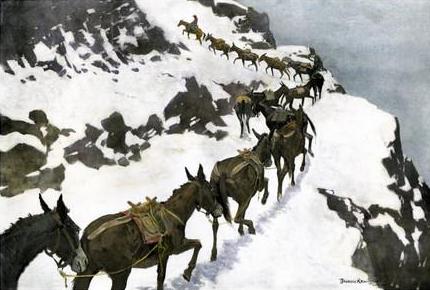
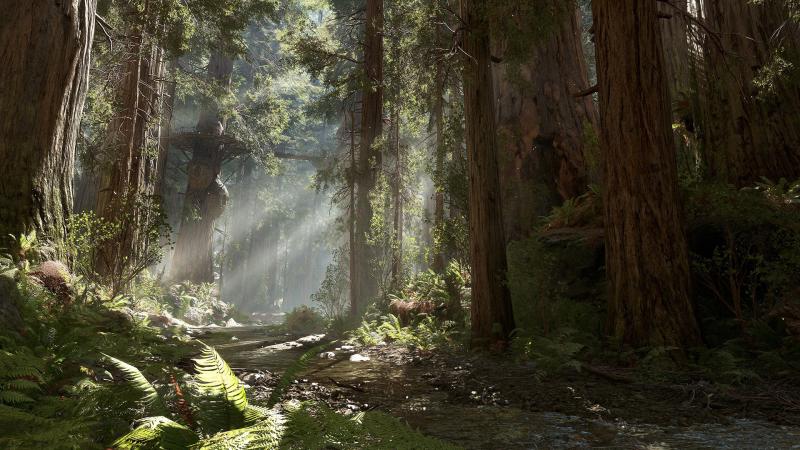 The Northern Forests are the lands that lie on the northeast shore of the Inner Sea and are covered in dense temperate forests. Near the coast the climate is quite mild but a few hundred miles north arctic winds cause more of a subarctic climate dominated by coniferous taiga woodlands. The Northern Forests are the homeland of wood elves and kaas and many of the larger fortress cities of the skeyn. They are also the main region where treants, giants, shie, and dragons rule over the lands and many abandoned and inhabited fey castles can be found.
The Northern Forests are the lands that lie on the northeast shore of the Inner Sea and are covered in dense temperate forests. Near the coast the climate is quite mild but a few hundred miles north arctic winds cause more of a subarctic climate dominated by coniferous taiga woodlands. The Northern Forests are the homeland of wood elves and kaas and many of the larger fortress cities of the skeyn. They are also the main region where treants, giants, shie, and dragons rule over the lands and many abandoned and inhabited fey castles can be found.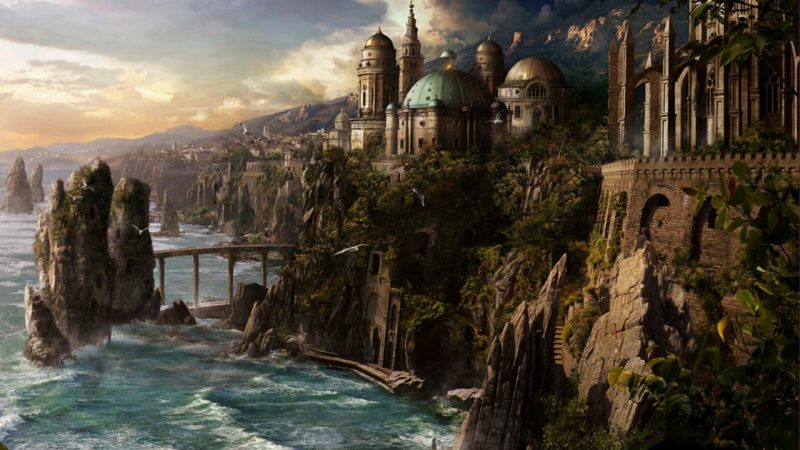 The city states of the Inner Sea are found scattered across the southeast coasts and the nearby islands but the region also includes the Akai Mountains to the east and the Tavir Highlands to the south. The coast is mostly populated by wood elves but is also home to large number of skeyn and some outposts of jungle elves that serve as harbors for ships transporting goods between the Inner Sea and the South. The Akai Mountains are the homeland of the yao who have few large settlements of their own and are mostly hunters and herders in a comperatively barren land. The Tavir Highlands are a desolate place feared by most people as they are prone to earthquakes and covered in small volcanoes and bottomless crevices of which many lead down into the underworld. The Highlands are home to the wilders, primitive and savage people of mixed wood elf and jungle elf ancestry that are said to worship the spirits of the Underworld.
The city states of the Inner Sea are found scattered across the southeast coasts and the nearby islands but the region also includes the Akai Mountains to the east and the Tavir Highlands to the south. The coast is mostly populated by wood elves but is also home to large number of skeyn and some outposts of jungle elves that serve as harbors for ships transporting goods between the Inner Sea and the South. The Akai Mountains are the homeland of the yao who have few large settlements of their own and are mostly hunters and herders in a comperatively barren land. The Tavir Highlands are a desolate place feared by most people as they are prone to earthquakes and covered in small volcanoes and bottomless crevices of which many lead down into the underworld. The Highlands are home to the wilders, primitive and savage people of mixed wood elf and jungle elf ancestry that are said to worship the spirits of the Underworld.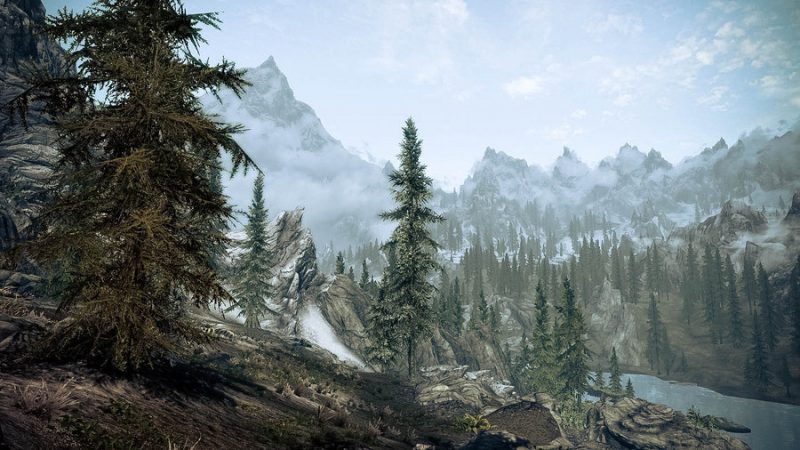 The Lands of Mist all have a subarctic maritime climate, which means cool and damp summers and freezingly cold damp winters. It’s damp pretty much all the time, overcast more often than not, and one of the few places in the Ancient Lands where moors, marshes, or even barren rock are just as common as woodlands. Population here is sparse, even compared to the rest of the world, and those people who settled here did so out of necessity rather than choice. There are some wood elves and kaas living here, as well as some mining outposts of skeyn. But most people are either jungle elves who have eatablished colonies that export dried fish to the south, or the Kaska, a group of savage yao who have fled to this distant corner of the world to flee the wrath of their gods.
The Lands of Mist all have a subarctic maritime climate, which means cool and damp summers and freezingly cold damp winters. It’s damp pretty much all the time, overcast more often than not, and one of the few places in the Ancient Lands where moors, marshes, or even barren rock are just as common as woodlands. Population here is sparse, even compared to the rest of the world, and those people who settled here did so out of necessity rather than choice. There are some wood elves and kaas living here, as well as some mining outposts of skeyn. But most people are either jungle elves who have eatablished colonies that export dried fish to the south, or the Kaska, a group of savage yao who have fled to this distant corner of the world to flee the wrath of their gods.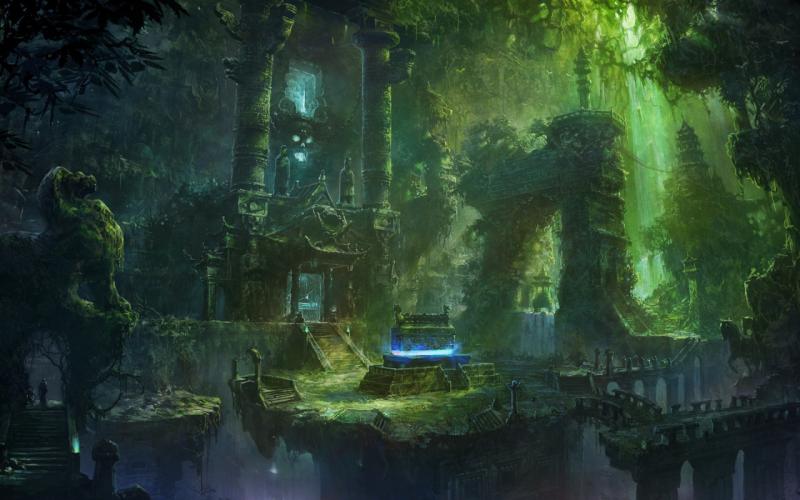 The Southern Jungles lie south of the southernmost parts of the Inner Sea and also include the many islands that lie off the coast to the west and north. Both the mainland and the islands are home to jungle elves and lizardmen but even further south lies the mystical land of Kemesh, which to this very day is under the control of various powerful naga city states. The naga themselves only make up a small portion of the population, which consists almost entirely of elven and lizardmen slaves. The free tribes of both peoples are in an eternal war with the naga, but this has settled into a permanent state of mostly minor skirmishes and raids for many centuries now.
The Southern Jungles lie south of the southernmost parts of the Inner Sea and also include the many islands that lie off the coast to the west and north. Both the mainland and the islands are home to jungle elves and lizardmen but even further south lies the mystical land of Kemesh, which to this very day is under the control of various powerful naga city states. The naga themselves only make up a small portion of the population, which consists almost entirely of elven and lizardmen slaves. The free tribes of both peoples are in an eternal war with the naga, but this has settled into a permanent state of mostly minor skirmishes and raids for many centuries now.